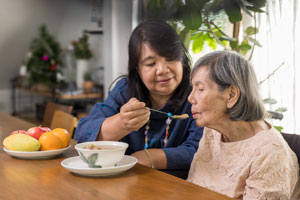Finding the Equity in Healthcare
By Jena Pierce on
In 2021, the Centers for Disease Control and Prevention (CDC) reached out to state health departments with a goal to reduce health equity disparities related to COVID-19 and to reach high-risk and underserved populations, including racial and ethnic minority populations and rural communities. The health departments were encouraged to work with their State Office of Rural Health (SORH). The North Dakota SORH is housed at the Center for Rural Health (CRH), within the University of North Dakota School of Medicine & Health Sciences.
CRH received $3.2 million for the COVID-19 Health Disparities Grant (no longer available online), passed through from the North Dakota Department of Health and Human Services, to work with rural hospitals, provide education and analysis around value-based care and payment, workforce training and development, expansion of behavioral health resources, and offer assistance with tribal caregivers. The funding was divided between five projects focusing on these areas.
CAH Physical Plant Grants
The COVID-19 pandemic brought to the forefront the immediate dangers of infectious diseases, especially in a healthcare setting.

Twelve grants were awarded to North Dakota Critical Access Hospitals (CAHs) to put toward a strategic analysis of physical plant needs of their system. Another option was to use the funding for the actual implementation of physical plant needs found as a result of an external strategic analysis. The program allowed 32% of CAHs to see where updates were needed and, in some cases, make the actual physical updates – helping to keep patients, families, visitors, and staff safer.
Kylie Nissen, CRH grant program director and SORH director, shared that many hospitals within the state were built in the 1960s or earlier and were not equipped to handle some modern-day concerns.
The hope was that these physical plant grants could help to better prepare our health facilities for treating patients in the future.
"It is very difficult for health facilities to be able to secure grants for funding physical plant projects," said Nissen. "Things as simple as automatic doors to reduce the transmission of germs through the touching of door handles were not a feature in many facilities. The hope was that these physical plant grants could help to better prepare our health facilities for treating patients in the future. It has been fun to be able to go to some of the facilities and see the changes that have been made!"
Focus on Value
The Rural Health Value Project (no longer available online) was developed as a working group to examine the intricacies of moving from volume-based to value-based care at CAHs, a shift prompted by the Centers for Medicare & Medicaid Services' (CMS) plan to move toward a system that focuses on population health, to be instituted by 2030. The thought behind a value-based system is to improve both health status and the healthcare system by emphasizing health outcomes and improvement rather than volume – the number of tests, procedures, and encounters.
CAHs were invited to apply to join the group, and five CEOs were chosen to serve as an advisory board, working with consultants from the University of Iowa, Stratis Health, and Newpoint Healthcare Advisors.
The group produced a number of successes: providing statewide education to all North Dakota CAHs, technical assistance/coaching, an environmental scan, and creating a policy roadmap. North Dakota healthcare facilities are prepared to lead the way through the transition of value-based care due to the work of the group.
Capturing Workforce Needs
The healthcare workforce faces many challenges and the COVID-19 Health Disparities Grant was the perfect opportunity to offer some assistance to current working professionals, students studying various health professions, and to expose healthcare opportunities to high school students.
 Resiliency training was offered to current healthcare
professionals to increase mindfulness, resilience, and
healthy behaviors while reducing anxiety, burnout
symptoms, and stress. Thirteen key healthcare
professionals received a Certified Resilience Trainer
(CeRT) certification, qualifying them to offer this
training to other healthcare professionals within the
state. Forty-seven medical students received HappiGenius
training and are able to teach the content to elementary
students in the state, therefore giving students social
and emotional skills early on to improve their life.
Resiliency training was offered to current healthcare
professionals to increase mindfulness, resilience, and
healthy behaviors while reducing anxiety, burnout
symptoms, and stress. Thirteen key healthcare
professionals received a Certified Resilience Trainer
(CeRT) certification, qualifying them to offer this
training to other healthcare professionals within the
state. Forty-seven medical students received HappiGenius
training and are able to teach the content to elementary
students in the state, therefore giving students social
and emotional skills early on to improve their life.
Housing availability and costs have proven to be a barrier to getting healthcare professions students to train in rural areas. Funds were used to help 83 students with housing needs, increasing their exposure to rural needs in their preferred area of study, and potentially leading them to practice in those or similar communities after graduation.
Introducing high school students to a wide array of healthcare professions has proven to increase their interest and study after high school. HOSA Future Health Professionals is a career and technical organization dedicated to preparing students for careers in the health sciences. With funding to help establish and sustain chapters, five new chapters were started in rural communities, bringing the total number of HOSA chapters in North Dakota to 16.
Collaborative Care
Collaborative care is treatment which is integrated within multiple disciplines in an effort to provide the patient with the best care. To increase the providers' knowledge of this model with behavioral health, virtual education sessions were offered through Project ECHO to train rural and tribal medical healthcare providers on how to screen, triage, and refer patients in rural and tribal communities for behavioral health services.
Eight ECHO sessions were given with family medical residencies and five statewide sessions were offered with continuing education credits on a variety of behavioral health topics. Funding also helped with the expansion of the Behavioral Health Bridge website, which offers professionals, and the public, resources and screening tools to assist with behavioral health issues.
Caring for the Caregivers
 CRH's National Resource Center on Native
American Aging (NRCNAA) partnered with the North
Dakota Health Equity Office and North Dakota tribes to
identify needs in caregiving and provide education and
tools, caregiving training opportunities, and technical
assistance for the Tribal Caregivers Project. NRCNAA
worked to identify healthcare options, such as
telemedicine, to ensure safe access to direct services
are provided to tribal Elders to age in place safely at
home as they received the vital services needed to
enhance a better quality of life.
CRH's National Resource Center on Native
American Aging (NRCNAA) partnered with the North
Dakota Health Equity Office and North Dakota tribes to
identify needs in caregiving and provide education and
tools, caregiving training opportunities, and technical
assistance for the Tribal Caregivers Project. NRCNAA
worked to identify healthcare options, such as
telemedicine, to ensure safe access to direct services
are provided to tribal Elders to age in place safely at
home as they received the vital services needed to
enhance a better quality of life.
Needs assessment studies and surveys were completed with different groups to identify the challenges and needs of Elders and caregivers related to COVID-19. Tribal community-specific tools and resources were created to address and overcome barriers due to COVID-19 for skilled and family caregivers, while technical assistance and training opportunities were also provided. Attention was also given to utilizing telemedicine as a healthcare option for tribal Elders, decreasing the needs to travel for treatment.
Investment in the Future
North Dakota rural health systems have always provided great care to their patients, but the pandemic brought forth new issues and exposed vulnerabilities for all systems throughout the world.
"COVID-19 wasn't an issue that affected one area of healthcare," said Nissen, "it hit the whole system. North Dakota rural health systems have always provided great care to their patients, but the pandemic brought forth new issues and exposed vulnerabilities for all systems throughout the world. This funding enabled us to target multiple areas that were affected in a variety of ways so that our facilities can be better prepared, for not only another pandemic, but for improved care for patients on a daily basis."
Because of the CDC's health equity investment, North Dakota facilities, providers, and patients are better positioned to lead healthier lives.


 is the communications manager at the Center for Rural
Health at the University of North Dakota School of
Medicine & Health Sciences in Grand Forks.
is the communications manager at the Center for Rural
Health at the University of North Dakota School of
Medicine & Health Sciences in Grand Forks.



